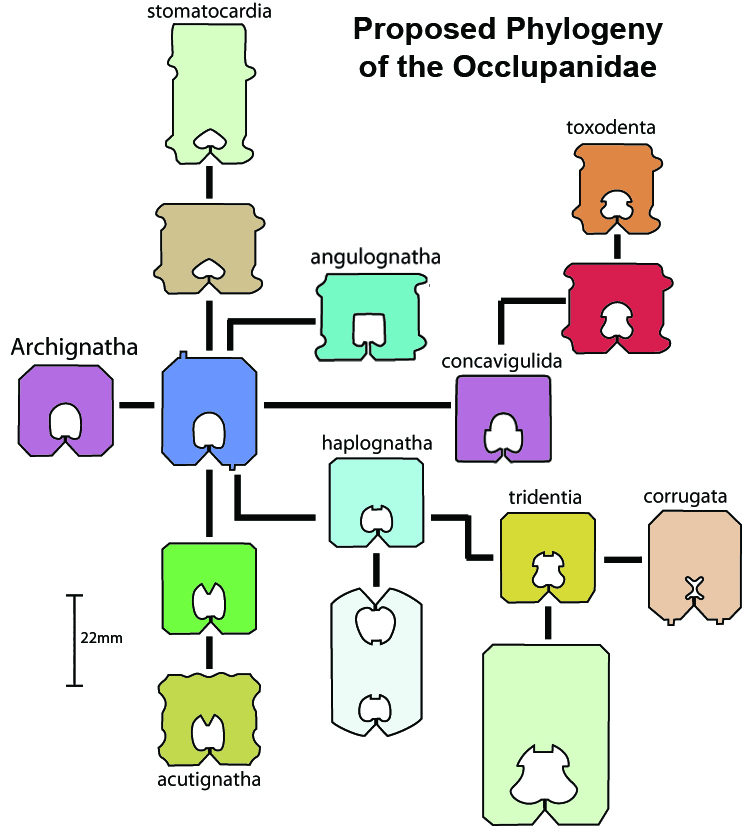Introducing the Holotypic Occlupanid Research Group
« previous post | next post »
For those who enjoy botanizing in realms of material culture:
This site contains several years of research in the classification of occlupanids. These small objects are everywhere, dotting supermarket aisles and sidewalks with an impressive array of form and color. The Holotypic Occlupanid Research Group has taken on the mantle of classifying this most common, yet most puzzling, member of phylum Plasticae.
Class Occlupanida (Occlu=to close, pan= bread) are placed under the Kingdom Microsynthera, of the Phylum Plasticae. Occlupanids share phylum Plasticae with “45″ record holders, plastic juice caps, and other often ignored small plastic objects.

[Tip of the hat to Mac McLemore]
Note that there are alternative taxonomic geometries that were popular in pre-Darwinian days, such as William Sharp MacLeay's Quinarian System. For some discussion, see "Trees spring eternal", 11/23/2003, and "Missing link: The early years", 10/16/2009.

a George said,
June 22, 2014 @ 4:23 pm
Nobody has commented, so presumably this subject is of no interest whatsoever. BUT, classification is one of major activities of our conquering of the world, so a few words of context may be in order anyway.
We may have cases of misclassification here, provided Aluminestrae refers to objects containing aluminium (as it is called over here). The iconic Donald Duck crown cap may actually be of steel, as well as the core of the binder and the staples (unless they are automatic staplers joined to copiers). The only certain aluminium part is the broken-off lever for a can.
The Plasticae is quite interesting because it contains some quite old items. The "45" adapter (not "record holder") could be as old as 1949, the year RCA introduced their single, a 45 rpm record with a large centre hole to accommodate the record changer mechanism, which was built into a tower and could switch to the next record side within a second. The adapter was needed if you wanted to center a record on a turntable with a small pin. Some record companies made the adapter integral to the record, and you had to break it out to obtain the larger hole. The sword became popular around 1960 as a cocktail snack stick, but it also armed huge numbers of doll's houses for their inevitable battles. The plastic juice cap was also used for various brands of cola, and it is the type that shows if the seal has been broken – tamper evidence. This particular type appeared around 1980.
So, now you have been fed useless information. I shall not try to classify the taxonomy we were presented with! But I am very happy to have read the BMJ Case Report.
Jerry Friedman said,
June 22, 2014 @ 10:10 pm
I think Phylum Aluminestrae is supposed to contain inorganisms made of other metals, sort of the way Ranunculaceae contains plants that don't resemble buttercups (or froggies) all that much.
By the way, the broken-off lever for a can is known in America as a "pull tab".
Colin Fine said,
June 23, 2014 @ 8:00 am
I think a George is committing the Etymological Fallacy. Next he'll be claiming that all Carnivora are carnivorous.
a George said,
June 23, 2014 @ 9:13 am
— alas, ever since I found out that atom and individuum were one and the same I have suffered from this condition.
Thomas Rees said,
June 24, 2014 @ 12:50 am
The 'pull tab' was an older form, now presumably extinct, with an annular body and a conjoined spatulate appendage. Or possibly the other way around.
tk said,
June 24, 2014 @ 7:11 am
Unmentioned is the fact that the coloration of Occlupanids varies in a septenial sequence, directly related to bakery delivery and, allegedly, oxidation date.
CrisisMaven said,
June 24, 2014 @ 9:58 am
Actually, classification is THE means of making sense of the world. Without classification, our brain would not function. Unbeknownst to most brain users though, classification happens rather subconsciously. Most classifications are implicit. There once was an aptitude or intelligence test for children. It had a picture with four animals, say, a pig, a horse, a cow and a monkey. The question was "which one is the 'odd one out'?". All Christian or "Western" children would normally recognize that a monkey is not a domesticated animal. But for Muslim children a pig is an uncouth animal, all the others are "ok to touch" for example. So these children always had worse "grades" in this part of the test until finally some researcher got wise to the underlying difference in classification. From here to extraterrestrials we may assume they have different classification systems and it is these meta systems, not the object space itself, that might initially make communication cumbersome.
Jerry Friedman said,
June 24, 2014 @ 1:11 pm
Thomas Rees: A Google Image search of the current literature shows that many taxonomists consider "pull tab" a valid name for the entire clade. Have the splitters published a name for the Cenoindustrial form?
Kenny Easwaran said,
June 27, 2014 @ 2:18 pm
This article gave an interesting insight into the history of some of these entities:
http://www.businessweek.com/articles/2013-03-13/twist-ties-vs-dot-plastic-clips-a-10-dot-6-billion-battle-of-tiny-titans
Keith said,
June 29, 2014 @ 3:14 pm
@ChrisMaven,
of "pig, horse, cow, monkey" the odd one out could be "monkey" for the reason that it is not a quadruped, could be cow because it is the one whose milk we drink, could be horse because it is the one we ride on, and could be pig because it is the one whose internal organs and teeth are the most like out own…